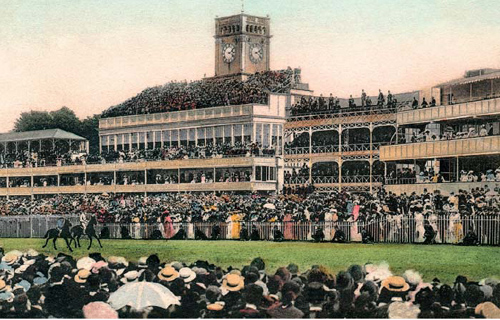

The grandstand at Ascot, packed to absolute capacity in 1904. The horses in this card look as though they have been added later by an artist – perhaps in the original photograph they were too blurred to be acceptable. They appear smaller than would be expected!

Taken during the 1903 St Leger meeting, this animated scene was captured as King Edward VII visited the course. The king was a regular visitor to the racetrack.
‘Scarcely a week elapses in the racing or steeplechasing seasons without some opportunity being given the turfite for the pursuit of his favourite amusement’, wrote Charles Dickens Jnr in the late 1880s. ‘The most famous of the metropolitan racecourses is Epsom, with its time-honoured traditions of the Derby and Oaks; and one of the London weeks is the “Derby week”, which is at the end of May or the beginning of June.’ He also recorded his opinion that ‘it is useful to remember that racecourse refreshments are almost always abominable, and that it is well to have as little to do with them as possible.’
Dickens never seems to have been reluctant to speak his mind, and, having bemoaned the high prices charged for access to the stands at both Epsom and Ascot in his Dictionary of London 1888 – an Unconventional Handbook, he warns would-be race-goers: ‘There are, probably, even more welshers and thieves at the London race meetings than elsewhere, because the meetings, being more numerous and close at home, afford more constant employment to these industrious classes. The visitor who wants a wager should be very shy of depositing his money with anybody he does not know, and unless he is acquainted with a respectable bookmaker, ought to keep his money in his pocket. If not, he will most assuredly never see it again.’ Wise advice, perhaps, even today! As these pictures show, the high prices did not discourage the race-goers one bit.

This view of the paddock and grandstand at Doncaster Racecourse, c.1909, shows the animated scene at the end of a race as the winner is led in. The card was one of a series supplied, according to the print on the back, ‘free exclusively by Shurey’s Publications’, comprising ‘Smart Novels’, ‘Yes or No’ and ‘Dainty Novels’. The sheer number of cards of the Doncaster meeting underlines the importance of the picture postcard during the Edwardian era. Doncaster’s royal patronage no doubt contributed to its success.

Huge crowds at Doncaster races for the 1906 St Leger, published in ‘The Wrench’ postcard series. This card was posted in 1907.
Ascot Races were listed among the social events of the year, and detailed reports listing the rich and famous who turned out – and often what they wore as well – were carried in all the magazines that might be read by the upper echelons of English life. One correspondent, writing for the magazine Chic in 1904, described the scene in almost poetic terms, creating a word picture of the cream of Edwardian English society at play.
‘The opening day of Ascot Races’, he wrote, ‘was the most brilliant that can be remembered. The lawns were crowded with a fluttering mass of beautifully gowned women and men in frock coats and top hats, and when the King and Queen arrived it would be difficult to imagine a more beautiful scene than was presented to the eye; the moving mass of human beings resolving itself into a veritable kaleidoscope of brilliant colour.’

The royal coach awaits the departure of King Edward VII from Doncaster races in 1903.

The horses approach the winning post during one of the races at the summer 1909 meeting at Chester racecourse.

In this 1905 view, entitled ‘Epsom, the Winning Post’ the photographer has chosen to take his picture from an unusual viewpoint, looking over the bookies’ enclosure towards the stands. In so doing, he has offered us a rare view over the tented village and gypsy caravans, which were the temporary homes of the many people who congregated around the racecourse, running food and drink stalls, and the other amenities that added to the excitement of the event.